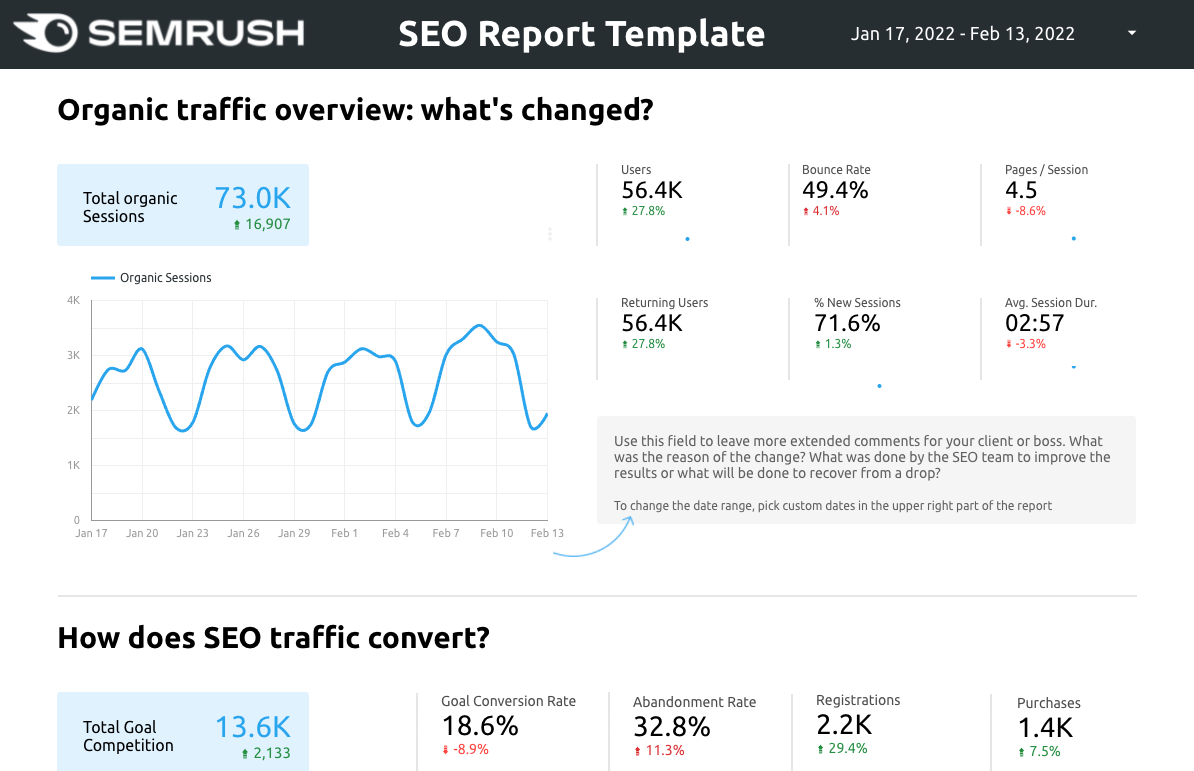How to Create an SEO Project Management Plan
Developing an SEO project management plan is crucial for achieving success. Before delving into the details, it’s important to determine the necessary tools required for the project’s successful implementation.
These tools may include SEO software, a communication and collaboration platform, as well as methods for tracking progress, time, and budget.

To create an effective SEO project management plan tailored to your specific objectives, follow these steps:
1. Define the scope, objectives, and goals of your SEO strategy with your clients
By setting these parameters at the beginning, you can prevent the need for multiple revisions or additions, as well as avoid scope creep.
To ensure the success of your SEO project, it is crucial to define your objectives beforehand. Start by having a discussion with your client to determine their desired outcomes.
The ultimate goal should be to meet the unique requirements of your client’s business. Develop an SEO plan that is tailored to achieve your goals. Set practical, quantifiable targets that can be divided into smaller tasks and subtasks.
As a project manager for SEO, it is often necessary to demonstrate the progress of the results to the client. A useful tool for consolidating data on traffic, bounce rates, and conversion rates into a single report is a Data Studio template, such as the one provided by SEMrush. This can help you to quickly gather and present key metrics to your client in an organized and visually appealing way, making it easier to track progress and identify areas for improvement.

2. Create a comprehensive list of all the tasks that need to be completed.
By creating a list of the necessary tasks for your SEO campaign, you can determine the necessary requirements to accomplish your objectives.
Once you have established your objectives, the next step is to identify the requirements needed to achieve them. Effective communication and collaboration with clients are critical factors to consider.
To ensure the success of the project, it is essential to have the full support of all stakeholders. They must be kept fully informed of the project’s plans throughout its duration, making efficient communication and collaboration crucial.
In an SEO project, there are typically multiple stakeholders involved, such as the tech SEO, SEO strategist, content manager, and outreach manager. It is important for all stakeholders to maintain good communication and keep each other informed of their respective team’s activities.
An SEO project plan can involve a wide range of tasks, depending on the specific objectives and scope of the project. Here is a comprehensive list of tasks that may need to be completed in an SEO project plan:
- Define project objectives and KPI’s.
- Conduct a comprehensive SEO audit of the website.
- Analyze keyword research and identify relevant keywords and topics.
- Develop a content strategy based on the keyword research and content gaps.
- Optimize on-page elements such as title tags, meta descriptions, header tags, and internal linking structure.
- Conduct technical SEO audit and address any technical issues such as crawl errors, broken links, and mobile responsiveness.
- Optimize website speed and performance.
- Implement structured data markup to improve search visibility and appearance in search results.
- Create and implement a backlink strategy to improve domain authority and referral traffic.
- Develop a social media marketing strategy to increase brand visibility and attract social signals.
- Analyze user experience and make recommendations to improve site engagement and reduce bounce rates.
- Monitor and analyze website analytics to measure progress and adjust strategies as needed.
- Create reports and presentations to communicate progress and results to stakeholders.
- Conduct regular SEO maintenance and updates to maintain search engine rankings and visibility.
It is important to note that this is not an exhaustive list, and some tasks may not be applicable for all SEO projects. Additionally, some tasks may need to be prioritized based on the project’s timeline and budget.

3. Outline and allocate the compiled tasks for completion.
It is essential that the tasks in an SEO project plan are aligned with the project’s overall objectives, such as increasing site traffic, sales, or brand awareness. It’s important to continually evaluate how each task contributes to achieving these objectives.
For instance, if the goal is to improve the client’s ranking position for specific keywords, it’s crucial to consider how that supports the broader project objectives. The goal can then be broken down into actionable tasks and smaller subtasks to make it more manageable. Here’s an example breakdown:
Goal: Improve ranking position for specific keywords
Tasks:
- Conduct keyword research to identify high-potential keywords.
- Optimize website content to include identified keywords.
- Optimize website structure and internal linking to support target keywords.
- Develop a link building strategy to increase domain authority and improve search rankings.
- Monitor search rankings and adjust strategies as needed.
Subtasks:
- Conduct a competitive analysis to understand what your competitors are doing.
- Optimize meta descriptions and title tags for target keywords.
- Optimize images on the website for target keywords.
- Create new, high-quality content focused on target keywords.
- Monitor backlink quality and disavow any low-quality links.
It’s important to prioritize these tasks based on the project’s timeline and budget and to continually assess progress towards the project’s overall objectives.

4. Formulate a realistic timeline for progress and completion of all tasks
Incorporate checkpoints for measuring progress at specific intervals to ensure the project stays on track. Additionally, consider adding specific deliverables, such as reports to management or stakeholders.
Creating a realistic timeline for an SEO project plan requires careful planning and consideration of the project’s objectives, scope, and available resources. Here are some steps to help create a timeline for an SEO project plan:
- Establish the project’s start and end date based on the project scope and objectives.
- Identify all the tasks and subtasks required to achieve the project objectives.
- Estimate the duration of each task and subtask based on available resources, complexity, and dependencies.
- Prioritize the tasks and subtasks based on their importance to the project objectives.
- Allocate resources and team members to each task and subtask.
- Consider any potential obstacles or challenges that may affect the project timeline.
- Determine milestones and checkpoints for monitoring progress.
- Create a Gantt chart or other project management tool to visualize the timeline and project progress.
Keep in mind that some tasks may take longer than expected, and unexpected obstacles may arise during the project. Therefore, it’s essential to build in some flexibility to the timeline and adjust it as needed.
It’s also important to communicate the timeline to all stakeholders to ensure everyone understands the project’s schedule and progress. Regular progress updates and status reports can help keep the project on track and identify any issues that need to be addressed to meet the project objectives.
5. Identify any potential roadblocks or risks that may arise during the project
This will help to minimize delays and prevent unforeseen issues from derailing your SEO project. Also establish contingency plans to address them effectively.
When planning an SEO project, it’s important to identify potential roadblocks and risks that may impact the project’s progress and success. Here are some common roadblocks and risks to consider:
- Technical issues: Technical issues with the website, such as slow page load speed, broken links, or incorrect indexing, can hinder SEO efforts.
- Changes in search algorithms: Search engine algorithms can change unexpectedly, and these changes can impact rankings and organic traffic.
- Competitors: Competitors can implement new strategies, increase their marketing budget, or target the same keywords as the project, making it difficult to achieve desired results.
- Content quality: Poor quality content or lack of fresh content can negatively impact search engine rankings and traffic.
- Budget constraints: Limited budget or resources can constrain the project’s progress and limit the team’s ability to execute certain tasks.
- Internal communication: Lack of communication or miscommunication between team members or stakeholders can lead to delays and misunderstandings.
- Client involvement: Lack of client involvement, feedback, or approval can slow down progress and make it difficult to achieve project goals.
Assess these risks and plan for them accordingly. Establishing contingency plans and setting realistic expectations can help mitigate these risks and keep the project on track. Communicating potential roadblocks and risks to all stakeholders can also help manage expectations and address issues as they arise.

6. Setup a communication and collaboration strategies
Effective communication and collaboration are crucial to the success of an SEO project. Here are some strategies to consider:
- Define communication channels: Establish clear communication channels for the project team and stakeholders. These channels may include email, project management tools, video conferencing, or regular meetings.
- Set expectations: Clearly define the expectations and roles of each team member and stakeholder. This includes outlining project milestones, deadlines, and deliverables.
- Assign a project manager: Appoint a project manager to oversee the project and serve as the main point of contact for all team members and stakeholders.
- Regular check-ins: Schedule regular check-ins to review project progress, discuss any roadblocks or risks, and ensure that everyone is aligned on the project’s objectives.
- Document progress: Document progress and share it with the project team and stakeholders. This includes regular status reports and updates on completed tasks, upcoming milestones, and any issues or risks that need to be addressed.
- Foster collaboration: Encourage collaboration and open communication among team members. This includes sharing ideas, best practices, and feedback.
- Client involvement: Ensure that the client is involved in the project and has regular opportunities to provide feedback and input. This helps ensure that the project is aligned with the client’s goals and expectations.
By implementing these strategies, the project team can work together more effectively and efficiently, ensuring that the project stays on track and achieves its objectives
In essence, having an organized plan of action to guide you through the project is crucial. The more experience you gain in SEO project management, the better you’ll become at creating and refining project plans and strategies.
7. Track your projects with a bird’s-eye view of your progress
Tracking the progress of an SEO project is critical to ensuring that the project stays on track and meets its objectives. Here are some tips for tracking your project with a bird’s-eye view:
- Use project management tools: Utilize project management tools such as Trello, Asana, or Jira to track tasks, deadlines, and milestones. These tools allow you to visualize progress and ensure that everyone is on the same page.
- Set up dashboards: Set up dashboards that provide a bird’s-eye view of project progress. This can include visualizations such as Gantt charts, burn-down charts, or other graphs that show progress over time.
- Track KPIs: Identify key performance indicators (KPIs) that measure the success of the project. These may include metrics such as organic traffic, rankings, and conversions. Use tools such as Google Analytics or SEMrush to track and analyze these metrics.
- Hold regular reviews: Schedule regular reviews of the project’s progress with the project team and stakeholders. Use these reviews to discuss progress, identify areas that need improvement, and adjust the project plan if necessary.
- Monitor risks and roadblocks: Keep an eye on potential risks and roadblocks that may impact the project. Use risk management techniques to mitigate these risks and keep the project on track.
- Share progress reports: Share progress reports with the project team and stakeholders. These reports should provide a clear overview of progress, KPIs, risks, and roadblocks.
By tracking your project with a bird’s-eye view, you can ensure that the project stays on track and achieves its objectives. This helps you make data-driven decisions and adjust the project plan as needed to achieve the best results.

